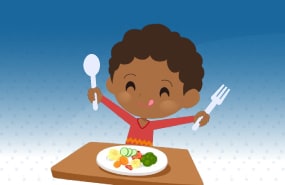Good Nutrition Starts Early
Children need fruits and vegetables daily for healthy growth and brain development. Early eating experiences can also affect how we eat as we get older. This is why it is so important to introduce young children to healthy foods, including a variety of fruits and vegetables.
Fruits and Vegetables
To help children grow strong, include fruit and vegetables with meals and snacks. Fresh, frozen, or canned options are all okay. With canned vegetables, look for products with low sodium. With canned or frozen fruits, choose those with little or no added sugars.
Prepare and store fruit and vegetables in single-serving containers. Then you’ll have a healthy snack ready when children are hungry.
How much fruit and vegetables children need depends on their age and how active they are. Use this chart as a general guideline, and use MyPlate Plan to calculate more precise recommendations.
| Daily Consumption Recommendation | ||
|---|---|---|
| Age | Fruit | Vegetables |
| 12 to 23 months | ½ to 1 cup | 2/3 to 1 cup |
| 2 to 4 years | 1 to 1 ½ cups | 1 to 2 cups |
| 4 to 8 years | 1 to 2 cups | 1 ½ to 2 ½ cups |
Source: USDA MyPlate
Include a variety of fruits and vegetables to make a rainbow of different colored foods on your child’s plate.
Here are a few examples:
- Fruits: bananas, strawberries, pears, oranges, melons, or avocados
- Vegetables: cooked spinach, carrots, peas, sweet potatoes, or beets
- Whole grains: whole grain breads, crackers, or pastas
- Meats: lean beef, lamb, chicken, fish, or turkey (soft, small pieces for children 6 to 12 months)
- Dairy: pasteurized yogurts or cheeses
Foods to Introduce First
When children are about 6 months old, you can start introducing them to foods and drinks other than breast milk and infant formula. For most children, you don’t need to introduce foods in a specific order.
By the time children are 7 or 8 months old, they can eat a variety of foods from different food groups. Your child needs a variety of vitamins and minerals to grow healthy and strong.
Avoid giving certain foods and drinks to children younger than 12 months.
Drinks Matter, Too!
When your child is between 6 and 12 months old, you can offer:
- Water (4 to 6 ounces per day)
- Breast milk (if you are still breastfeeding) or infant formula
Once your child is 12 months old, you can begin offering fortified cow’s milk.
If you want to serve your children fruit juice, the American Academy of Pediatrics recommends waiting until they are 1 year old. For children older than 1, serve only 100% fruit juice. Also, limit each serving to the recommended amount.
Beverages with no added sugars are the best choice. These include water and unsweetened, fat-free or low-fat milk. Low-lactose or lactose-free milk and unsweetened, fortified soy beverages are also healthy beverages.
Be Their Role Model
Once children are 12 months old or older, they will eat more of the foods that you eat. Healthy eating patterns set a good example for your children. Healthy eating patterns focus on fruits and vegetables, whole grains, lean proteins, and low-fat or fat-free dairy. It is also important to limit foods that are high in sodium and added sugars.
Unsweetened beverages are the best choice for adults too. See how to Rethink your Drink. Also, MyPlate can help you choose healthy foods and drinks for your family.
More Information
- Tips to Help Your Picky Eater
- Benefits of Healthy Eating for Adults and Children
- Learn How the Nutrition Facts Label Can Help You Improve Your Health
- Infant and Toddler Nutrition
- Dietary Guidelines for Americans, 2020-2025
- Foods and Drinks for 6 to 24 Month Olds
- USDA MyPlate Fruits and MyPlate Vegetables



